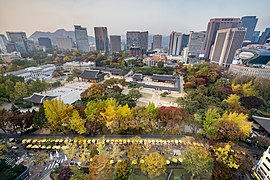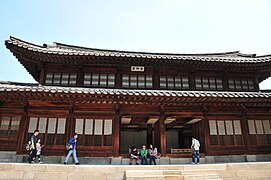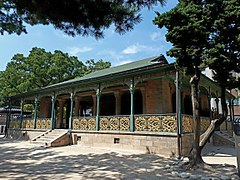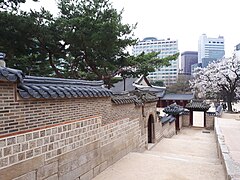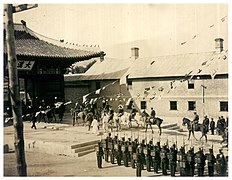Deoksugung
| Deoksugung | |
|---|---|
Jung-gu, Seoul | |
| Country | South Korea |
| Coordinates | 37°33′58″N 126°58′29″E / 37.56618°N 126.97485°E |
| Website | |
| www | |
| Deoksugung | |
| Hangul | 덕수궁 |
|---|---|
| Hanja | |
| Revised Romanization | Deoksugung |
| McCune–Reischauer | Tŏksugung |
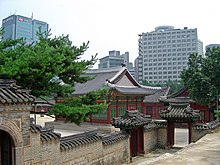

Deoksugung (
In addition to the traditional palace buildings, there are also forested gardens, a
Deoksugung, like the other "
Deoksugung Palace is special among Korean palaces. It has a modern and a western style garden and fountain. The Changing of the Royal Guard, in front of Daehanmun (Gate), is a very popular event for many visitors. The royal guard was responsible for opening and closing the palace gate during the Joseon dynasty. Outside of the palace is a picturesque road with a stone wall.[4]
The Deoksugung Stonewall walkway is at the heart of a popular urban myth in Seoul, as it is said that all couples who walk down this road are fated to break-up.[5]
History
Deoksugung was originally the residence of
In 1897, after the period when
Under Japanese rule after 1910, the palace grounds were operated as a public park, the territory was reduced to one-third and the number of buildings to one-tenth of the original.[11]

Buildings
Daehanmun Gate, originally called Daeanmun before 1906, is the main gate of the current palace.
The main hall, Junghwajeon Hall is where the state affairs, official meetings were held and where the throne is located. It used to be a two-story building but was rebuilt in 1906 with only one story.[10]
Junghwamun Gate is the gate that leads to the main hall. Originally it featured a walled corridor, thus allowing people to only enter the main hall through the gate. The walls were destroyed.[10]
Hamnyengjeon Hall is Emperor Gojong's bedroom, located at the east wing of the palace. This is where the fire broke out in 1904, officially because of the heating system, but it has been suspected that it was done by the Japanese to eliminate Gojong.[10]
Jeonggwanheon is a modern pavilion built in the royal garden in 1900, and was the first Western-style building ever built in a Korean royal palace. Although it was built by a Russian architect in a European style, it also features Korean elements. It was transformed into a cafeteria during the Japanese occupation.[10]
Seokjojeon is a Neo-Renaissance style building designed in 1898 by British architect John Reginald Harding, used for diplomatic and high-level government meetings. In 2014 its interior was restored to its Korean Empire-period appearance and now houses the Korean Empire History Hall.[12][13]
The Seokjojeon West Building was opened in 1938 as the House of Yi Art Museum, and continues to be used as an art museum today, housing the National Museum of Modern and Contemporary Art.
Jungmyeongjeon Hall, across Deoksugung-gil separate to the rest of the palace, was built to be a royal library but when the 1904 fire broke out, the emperor temporarily used it as his private residence.[10]
-
An aerial view of Deoksugung
-
Daehan Gate of the palace
-
Junghwajeon, the main hall of Deoksu Palace
-
The interior of the main hall
-
Seokeodang, two-story building of the palace built in the style of a private residence.
-
Jeonggwanheon, reception room in Deoksu Palace
-
The previous main gate.
-
Indoor walls of Deoksu Palace.
Transportation
Deoksugung entry is located 5-1 Geongdong-gil/Deoksugung-gil, Jung-gu. The nearest subway station is
Gallery
-
Jeonggwanheon during the era of Korean Empire
-
Deoksugung before 1904
-
Ruins of the palace after a great fire in 1904
-
Daehan Gate, andJapanese crown princevisited
-
Picture of Junghwajeon, Seokjojeon, Junghwa Gate, and Geonguk Gate
Bibliography
- Hoon, Shin Young (2008). The Royal Palaces of Korea: Six Centuries of Dynastic Grandeur (Hardback). Singapore: Stallion Press. ISBN 978-981-08-0806-8.
- Yoon, Jong-Soon (1992). Beautiful Seoul (Paperback). Seoul: Sung Min Publishing House.
References
- ^ "The 5 Palaces of Seoul". The Chosun Ilbo. 24 January 2012. Retrieved 23 April 2012.
- ^ a b c d "Deoksugung Palace (덕수궁)". Visit Korea. Retrieved 2021-11-25.
- ^ "일제에 의해 훼손된 옛 덕수궁 터이번엔 미대사관 신축부지로 전락". OhmyNews. 12 March 2002.
- ^ "Deoksugung Palace". Visit Seoul. Archived from the original on 29 November 2014. Retrieved 16 November 2014.
- ^ "Top 5 Places to Visit in Seoul with Korean Superstitions". english.visitseoul.net. Retrieved 2021-04-01.
- ^ a b "Chronology". Deoksugung. Retrieved 2021-11-25.
- ^ "한국사데이터베이스". db.history.go.kr. Retrieved 2022-05-21.
- ^ "한국사데이터베이스". db.history.go.kr. Retrieved 2022-05-21.
- ^ Russian Ministry of Navy Documents (13 May 1897). "1/13 Мая 1897 года". db.history.go.kr. Retrieved 2022-07-21.
- ^ a b c d e f "Buildings". Deoksugung. Retrieved 2021-11-25.
- ^ "History". Deoksugung. Retrieved 2021-11-25.
- ^ "석조전 대한제국역사관". Retrieved 2021-12-01.
- ^ Jae-un, Limb (October 8, 2014). "Century-old stone palace reborn as historical museum". Korea.net. Retrieved April 11, 2022.
- ^ "Deoksugung Palace". Korea Tourism Organization. Archived from the original on 2014-11-05. Retrieved 2014-09-03.

